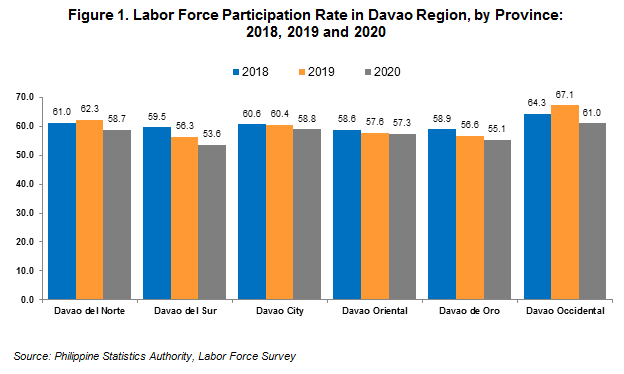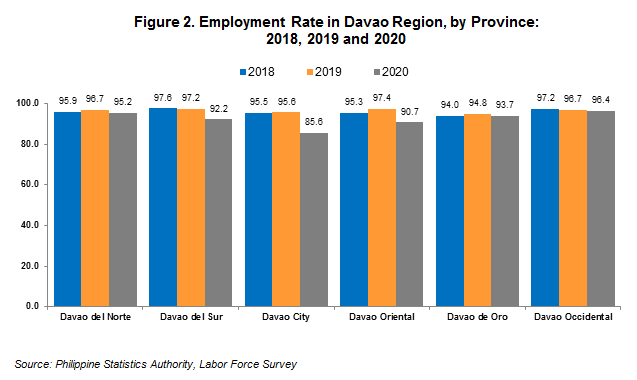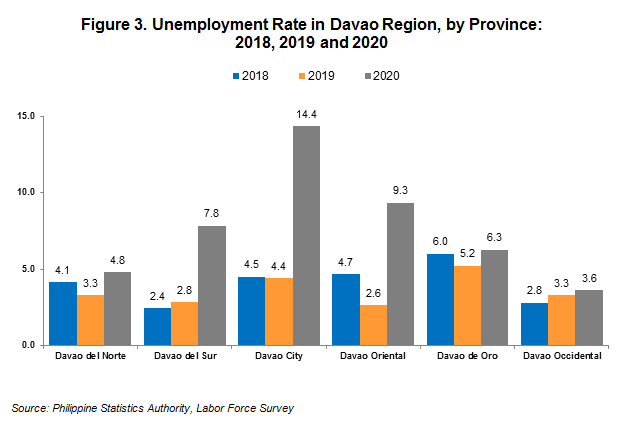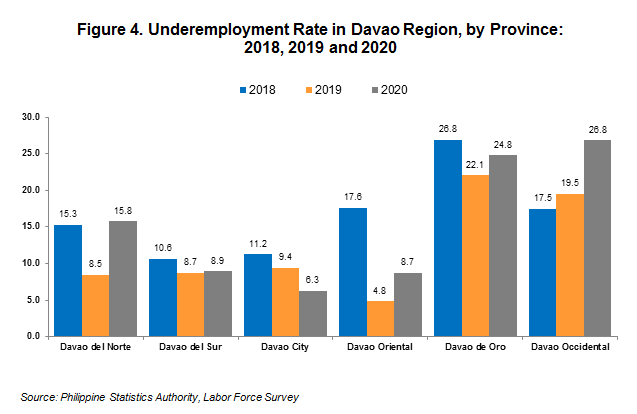Release Date :
Reference Number :
2022-011
 Over 2.05 million part of the total workforce population in Davao
Over 2.05 million part of the total workforce population in Davao Region Davao Region's total population 15 years old and over for year 2020 was at 3.56 million. Labor Force Participation Rate (LFPR) during this period was at 57.5 percent, accounting for 2.05 million economically active Davaoeños (see Table 1). This is 2.8 and 2.3 percentage points lower compared to the LFPR of year 2018 and 2019, respectively.

In year 2020, among the provinces and Highly Urbanized City in Davao Region, Davao Occidental reported the highest LFPR at 61.0 percent, followed by Davao City at 58.8 percent. On the other hand, Davao del Sur has the lowest rate at 53.6 percent. The provinces of Davao del Norte, Davao Oriental and Davao de Oro recorded 58.7 percent, 57.3 percent and 55.1 percent, respectively. (Figure 1)
Davao Occidental registers the highest employment rate in 2020
About 90.8% of the working-age population who were economically active or those who belong to the labor force in Davao Region are employed in 2020. This is 5.4 and 4.9 percentage points lower than of the previous years, 2018 and 2019. (Table 1)

Davao Occidental (96.4%) and Davao del Norte (95.2%) recorded the highest employment rate in Davao Region for year 2020. On the contrary, Davao City recorded the lowest employment rate with 85.6 percent in 2020. This is 10.0 percentage points lower compared to both 2018 and 2019. Moreover, Davao de Oro, Davao del Sur and Davao Oriental had employment rates more than 90.0 percent in 2020. (Figure 2)
Unemployment rate of Davao Region is at 9.2%
Davao Region posted an unemployment rate of 9.2 percent in year 2020, which is equivalent to 189 thousand Davaoeños. This is significantly higher compared to 4.3 percent in 2018 and 3.8 percent in 2019. (Table 1)

Davao City has the highest unemployment rate in year 2020 at 14.4 percent, accounting 105 thousand individuals. This was followed by Davao Oriental at 9.3 percent. The provinces of Davao del Sur, Davao de Oro, Davao del Norte and Davao Occidental recorded unemployment rate less than 8 percent in the same year. (Figure 3)
Davao Region’s Underemployment rate in the country is at 13%
Underemployed persons are employed persons who: expressed their desire to have additional hours of work in their present job or to have additional job, or to have a new job with longer hours of work. In year 2020, 13 percent of total employed Davaoeños reported to be underemployed. The underemployment rate for 2020 is higher by 1.9 percentage point than the underemployment rate posted in 2019 (11.1 percent). In 2018, underemployment rate was 15.4 percent. (Table 1)

Davao Occidental recorded the highest underemployment rate in year 2020 at 26.8 percent, followed by Davao de Oro (24.8%), Davao del Norte (15.8%), Davao del Sur (8.9%) and Davao Oriental (8.7%). On the other hand, Davao City has the lowest underemployment rate at 6.3 percent. (Figure 4)
Technical Notes
• The Labor Force Survey (LFS) is a nationwide quarterly survey of households conducted by the Philippine Statistics Authority (PSA) to gather data on the demographic and socio-economic characteristics of the population.
• The reference period used in the survey is the past seven (7) days preceding the date of visit of the enumerator. The number of sample households was about 43,000.
• The 2012 Philippine Standard Occupational Classification (PSOC) was adopted starting April 2016. The 1992 PSOC had been used prior to this round. Starting January 2019, the 2017 Philippine Standard Classification of Education (PSCED) was adopted. The categories for highest grade completed were also revised considering the K to 12 program in the education system.
• The population projections based on the 2015 Population Census (POPCEN 2015) has been adopted to generate the labor force statistics.
• In the April 2017 round of the LFS, Computer Aided Personal Interviewing (CAPI) using Tablet was utilized in the data collection. Starting April 2020, a hybrid approach was used in data collection, a mixed mode of CAPI face-to-face interview, whenever possible, or a telephone interview.
• Overseas Filipino Workers are not considered part of the labor force in the Philippines. Hence, in the LFS, data on economic characteristics of household members who are overseas workers are not collected. In the LFS report, they are excluded in the estimation of the size of working population, that is, population aged 15 years and older, and in the estimation of the labor force.
Approved for Release:
RUBEN D. ABARO JR., CESE
Regional Director
Regional Statistical Services Office XI
Philippine Statistics Authority
